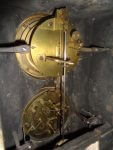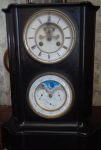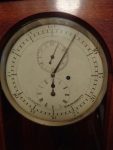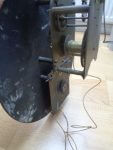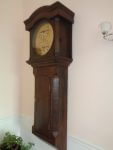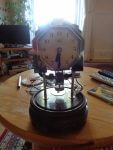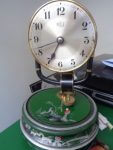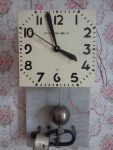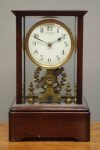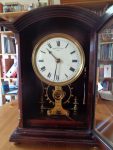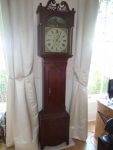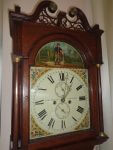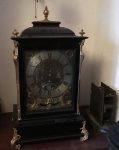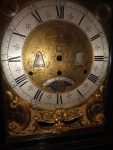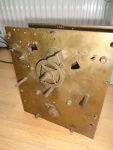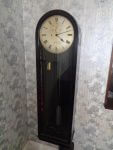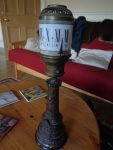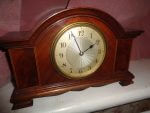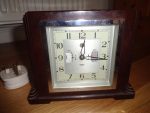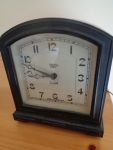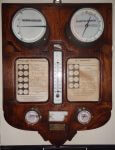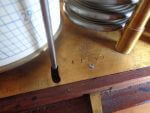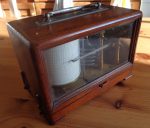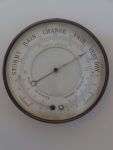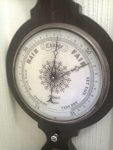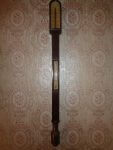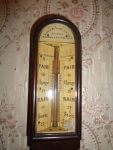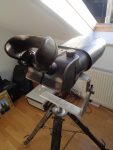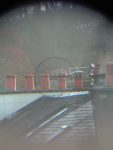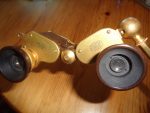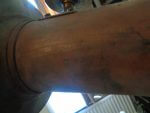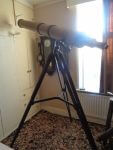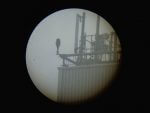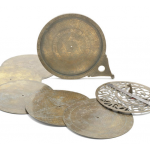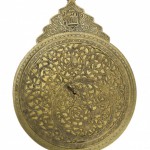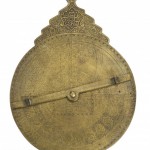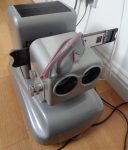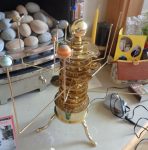Our interest in scientific instruments is shown by these items; click on the images to explore further.
French perpetual calendar clock
Nice example of a late 19th Century French perpetual calendar Brocot type mantel clock in black slate. 2 week movement with striking hours and one on the half hour.
- French Brocot movement with Perpetual Calendar – details of movement
- French Brocot movement with Perpetual Calendar
British Regulator Clock
From Allison’s of Monkwearmouth.
- Allison of Monkwearmouth
- Allison of Monkwearmouth
Derbyshire Mill Clock
Mill clocks feature extra dials that record factory production linked to the flow of water through the mill. They were used in the day of “the dark satanic mills” to “regulate” the workers’ pay. This one built by Roskell’s of Liverpool who took over Whitehurst of Derby features a brass dial with lower dial powered by a shaft that would have ran through the hole to the left of the dial.
- Mill clock Movement
- Derbyshire Mill Clock
Electric Clocks
These come in many forms – Bulle, Brille, Eureka, Magneta, Gents, Synchronome… My favourite is the Bulle and two examples are here – one an Art Deco creation the other with a Japanese theme reminiscent of the Mikado maybe…
After unearthing an old Brille I can now confirm that the Brille competes with the Bulle for my interest.
Included below are also a couple of clocks from the Eureka Clock Company London. These two fine examples, since moved on to new owners, are lovely clocks, though, in my opinion, requiring a little too much work in keeping them to time. The Eureka Clock company and their clocks are explained in the fine book by Alan Shenton – The Eureka Clock.
- Bulle clock Art Deco
- Bulle clock – Japanese
- Brille Clock
- Eureka Clock -825x
- Eureka Clock 7633
Long Case Clock
By Andrew Maule of Wooler then South Shields – early 19th Century.
Clock maker and workshop in Wooler 1801-1830, then in South Shields (possibly a son, Andrew took over), Broad Landing 1850.
Born in Scremerston, 1765 (according to church) to Andrew (born 1730, a blacksmith, married to Jane(?), son of J. Maule & Alison Darling) in the Parish of Ancroft. Married Jane, daughter of William Phirsin of Earlston, North Britain, and had many issues George 1797 (clockmaker Wooler); James 1798, baptised 1802 (clockmaker in Berwick); Jane 1801, baptised 1804; John 1806?. Andrew 1797-1850(?) – S Shields(?), William (clockmaker in Wooler then Coldstream, 1809).
John had son and grandson John who became clockmakers in Newcastle.
Died 1836 (in church records) and buried in St Mary’s churchyard, Wooler Jan 4th aged 70 years (grave not found).
The whole Maule clan seemed to move out of Wooler around 1855 due to dispute over who won the contract for the church clock tower.
Ref W.P.R. Pigot 1829, m
Reid lists 2 l.c. clocks
Loome 1827 lists one.
- Long Case Andrew Maule – Wooler circa 1820
- Andrew Maule – Dial & Woodwork Details
German Bracket Clock
Johannes Strickling of Mannheim, Germany built this clock in 1740 and, according to Jürgen Abeler, the author of the German clockmakers’ encyclopedia, a sister clock, very similar to the one below, existed in the Bayerisches National Museum in München, Germany. Actually this is not the case but it may refer to a clock in the Residenz Munchen which was there until WWII after which it disappeared (Ernst von Bassermann Jordan – Alte uhren und Ihre Meister, 1926). A sister clock as described in the Stadt archives of Mannheim 1922 does exist in the REM museum in the clock maker’s home city.
The clock, although missing its bells, strikers and train, is a fine and interesting example of a bracket clock of that era. It has being overhauled to return it to a working clock albeit without the bells. Enjoy the pictures. A report detailing the history of Johannes Strickling, his work and the restoration of this clock has been written and can be accessed from the archives of the Deutsche Gesellschaft für Chronometrie library in Nürnberg, Bayern, Deutschland.
- Johannes Strickling Uhr
- Strickling clock – face detail
- Strickling Movement
Reid & Sons Newcastle
Reid & Sons of Newcastle upon Tyne are still going strong. Here is an example of one of their slave clocks used in the system to maintain GMT throughout the city in the early 20th century.
A description of the time keeping system can be found here.
The clock has had its impulse system removed but the incoming contacts at the top may be seen in the photograph.
- Reid & Sons Regulator
Lighthouse Clock
A rare lighthouse clock from France, late 19th century. A clockwork mechanism provides the propulsion of the glass dial. Running time is around 12 hours on a full wind.
- Lighthouse Clock
Other Clocks
A nice French made clock for Hamilton & inches of Edinburgh; two nice Smith electric clocks.
- Hamilton & inches Edinburgh Clock
- Smiths electric clock.
- Smiths Electric Alarm Clock.
Lambrecht Wetter Telegraph
Lambrecht of Göttingen, Germany made a series of these “Wetter telegraphs” (Weather Forecasting Stations) in the early twentieth and late 19th centuries. This particular one the “Saussure” sold for around 130 Marks and was made from around 1910. One can read off the pressure (at sea level and the particular observation height of the station); the temperature; and the absolute humidity (and hence dew point temperature). This particular Telegraph was made for the Swiss market through Lambrecht’s sellers, Ulbrich in Zurich and for a French speaking station at an altitude of around 410metres. (We wonder where?…).
- Weather Station from Lambrecht Göttingen, Germany
French Barograph
A small late 19th Century French barograph by Richard Freres. Oak case with carrying handle with hinge to the side opening to reveal a stack of five vacuum disc bellow. Drum with eight day movement with brass fittings. Base stamped with maker’s marks and 17249. 7in x 4in x 5in (17.5 cm x 10cm x 12, cm) high together with a collection of Negretti & Zambra barograph papers (on disc).
- French Barograph by Richard Freres, Brevete, Paris, France – detail
- French Barograph by Richard Freres, Brevete, Paris, France
Richard Brevetes, Contructors Brevetes (SGDC), Paris, Made in France
Other Barometers
Nice round aneroid by Brevete, Paris with Reaumer, Celsius and Fahrenheit temperature scales; a banjo style classic from Kendal; a pocket barometer from Robson of Newcastle; a nice stick barometer for a firm in Glasgow.
- Aneroid Barometer – Brevete of France
- Wheel Barometer
- Wheel Barometer – J Moore Kendal.
- Robson of Newcastle
- Glasgow stick barometer
- Glasgow stick barometer
Other Weather Instruments
A Dine’s copper/gun-metal self-emptying rain gauge with clockwork pen and ink display disc.
- Dine’s rain guage
WW2 Schneider Binoculars
Schneider of Göttingen built these battleship binoculars for use around the 2nd World War. 25×105 – they give a wonderful field of view and high definition of imagery. A wonderful piece of German engineering weighing in at around 15Kg,
- Schneider Binoculars 25×105
- Schneider Binoculars 25×105
Other Binoculars
Delightful Teleater set by Zeiss of Germany – ideal for the opera house.
- Teleater by Zeiss
- Teleater Zeiss
Dallmeyer Refracting Telescope
Owned by Lord Armstrong of Cragside and Bamburgh and used in the old astronomical dome at Cragside before its demolition for the higher tower (circa 1880). 5 inch refractor by John Henry Dallmeyer – an Anglo-German optical engineer who worked for Ross before setting up on his own in London .
- Telescope by J.H. Dallmeyer – detail
- Lord Armstrong of Cragside’s Astronomical Telescope
- Image through Dallmeyer
Astrolabe circa 1947+
A ‘false’ astrolabe of engraved brass, provenance, Ishfahan Iran, made for the tourist trade and depicting the skill of local engravers that highlight the culture of the area. Mention of the state of Pakistan pinpoints the earliest date of manufacture.
- Complete
- Obverse
- Reverse
Specialists at the Royal Museum of Scotland have researched this astrolabe and some of the findings are summarised here; a more detailed document with annotations over images of the astrolabe can be obtained as a pdf document on request (via email, twitter, LinkedIn etc…)
Running around the zodiac in the mater of the astrolabe are place names of towns in Iran (e.g. Kirmanshah, Rasht, Mahabad); outside Iran (e.g. Kairo, Damascus, Multan); and also provinces of Iran (e.g. Tabaristan, Sistan). The signs of the zodiac are named in Persian and Arabic. The inscription in the kursi reads ‘al-ruhat 78 18 al-mantaqat’ which refers to the regions mentioned; the numbers are not clear but might have been thought of as a date. The other inscriptions either repeat the zodiac of give the names of stars. The astrolabe is judged to have been made in Iran from the Persian translation of the zodiac and from the head with the Safavid style turban in one of the scrolls of the rete.
Note all photographs and documentation are © National Museums of Scotland.
3-D Image Viewing
A Graphoscope – a novel 3-D picture viewer with postcard viewer; very fine Edwardian with intricate inlay. A nice piece. Then followed by a viewer from West Berlin by Pintsch-Bamag circa 1950-60s. This viewer utilises polarisation of two images from slide images, projection onto a sliver screen and subsequent viewing with 3-D glasses (polarised – rectangular).
- Pintsch-Bamag 3-D Viewer
- Edwardian Graphoscope
Miscellaneous Scientific Instruments
A nice modern Orrey from a recent magazine weekly offer. Build your own in 52 weeks!
- Modern Orrery

